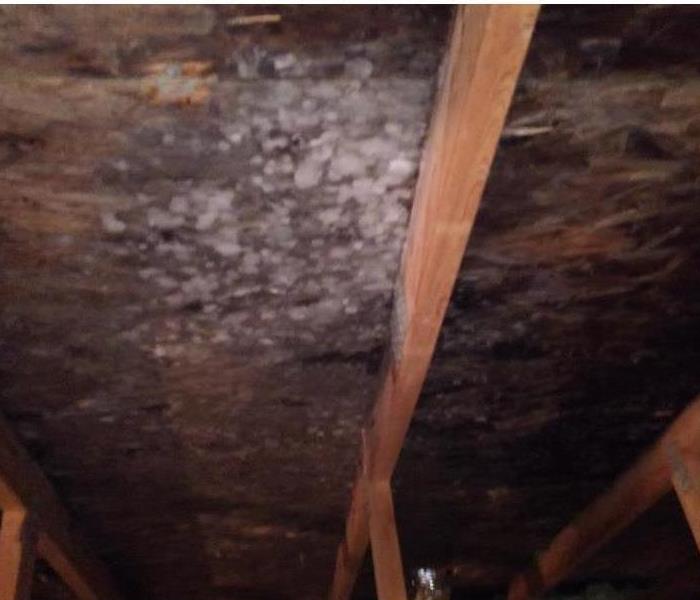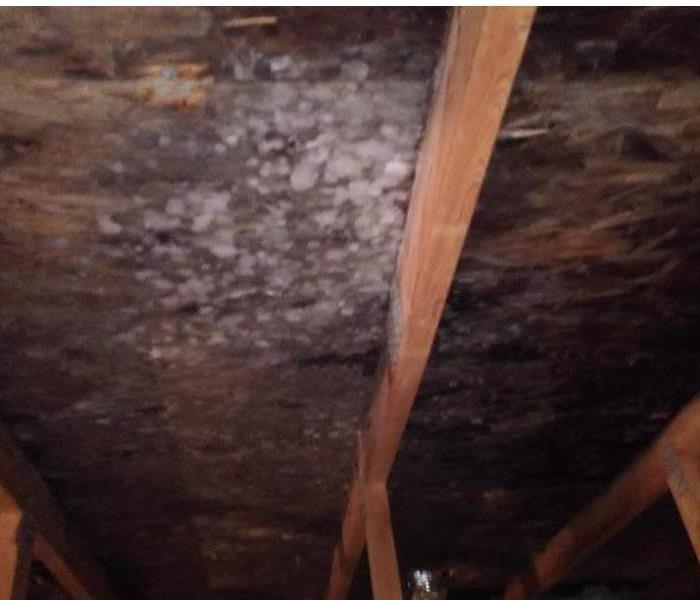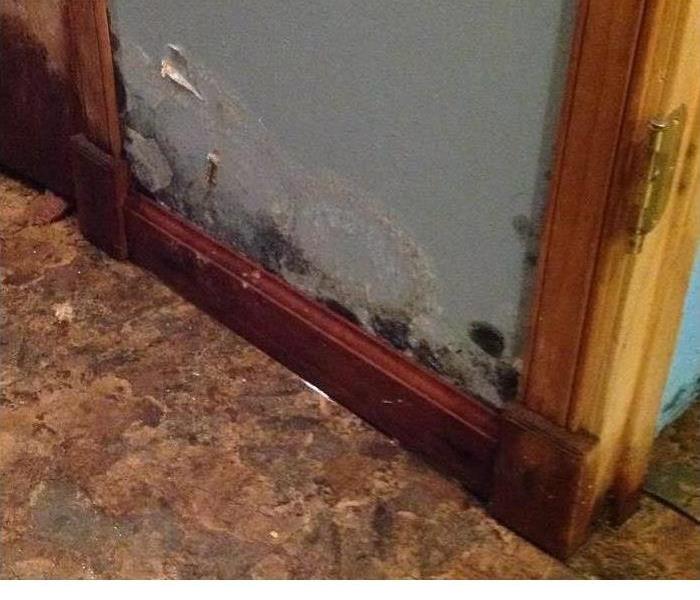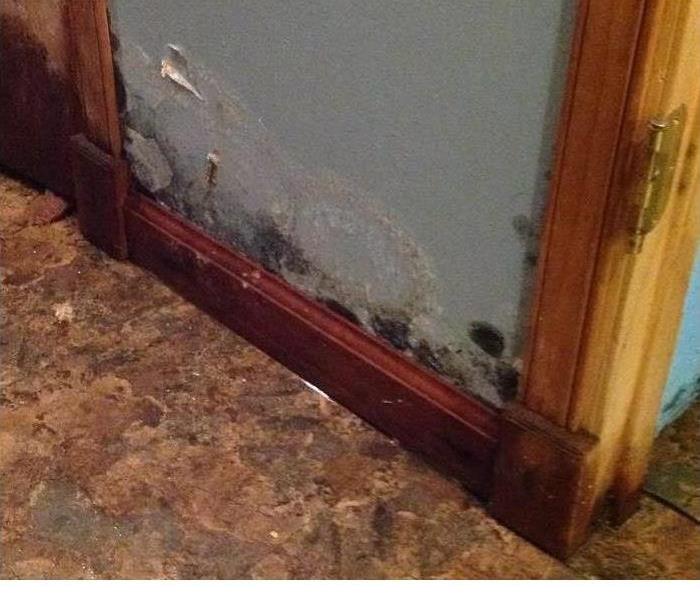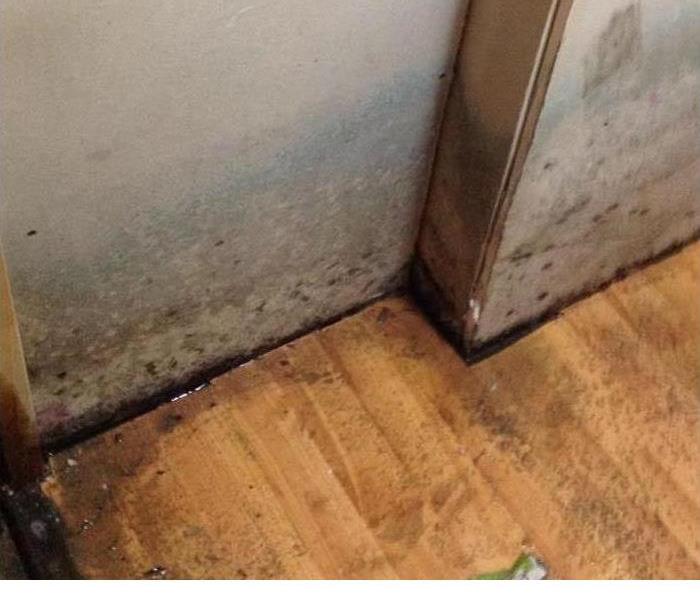Archived Mold Remediation Blog Posts
Understanding Black Mold
1/23/2024 (Permalink)
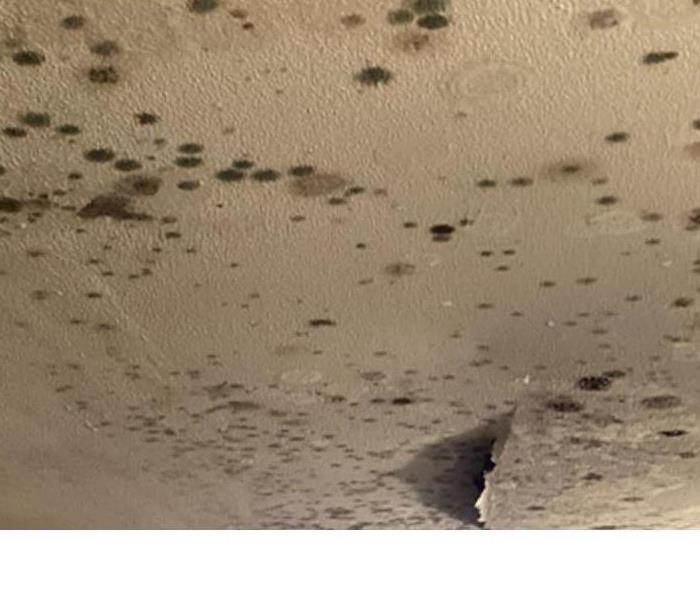 Black mold growing on ceiling, potentially compromising the integrity of the building
Black mold growing on ceiling, potentially compromising the integrity of the building
What is Black Mold, and Why is it a Concern?
Black mold, scientifically termed Stachybotrys chartarum, is a toxic mold variant that thrives in damp, humid conditions. Often characterized by its dark coloration, this mold is not just an aesthetic concern but poses significant health and structural risks. Its spores can exacerbate respiratory problems, allergies, and even lead to more severe health issues, particularly in those with compromised immune systems. Beyond health risks, black mold can also undermine the structural integrity of buildings, leading to costly repairs and devaluation of property. It is crucial for home and business owners to understand the gravity of black mold infestations and take proactive measures to mitigate its growth and spread.
Primary Causes of Black Mold Growth in Buildings
Understanding the root causes of black mold growth is essential for effective prevention and treatment. Primarily, black mold thrives in environments that provide moisture, organic material, and adequate temperatures.
- Moisture: The predominant factor for black mold growth is excess moisture, which can originate from several sources such as leaking pipes, roof leaks, condensation, or high indoor humidity. Buildings with poor drainage systems or those that have experienced flooding are particularly susceptible.
- Poor Ventilation: Inadequate ventilation in buildings leads to moisture accumulation, especially in high-humidity areas like bathrooms and kitchens. This lack of airflow not only supports mold growth but also prevents the drying out of damp areas, further exacerbating the problem.
- Building Materials: Black mold feeds on organic materials found in many building components like wood, drywall, and insulation. These materials, when exposed to moisture, provide the perfect breeding ground for mold.
- Temperature: Mold thrives in warm temperatures, typically found indoors. Buildings with inconsistent temperature regulation or poor insulation can have pockets of warmth that encourage mold growth.
Addressing these key factors is crucial in preventing and managing black mold in any building. By controlling moisture levels, ensuring proper ventilation, and using mold-resistant building materials, the risks associated with black mold can be significantly mitigated.
Identifying Early Signs of Black Mold
Early detection of black mold is crucial in preventing its spread and mitigating potential health risks. Being vigilant about the signs can help in taking timely action. Here are key indicators to watch for:
- Visible Growth: The most obvious sign is the appearance of dark, often black or greenish-black, splotches on surfaces, particularly in moist areas like bathrooms, kitchens, and basements.
- Musty Odors: A persistent musty, earthy smell is a strong indicator of mold presence, even if it's not immediately visible. This odor can be particularly noticeable in closed spaces or upon entering a room.
- Water Damage: Signs of water damage such as water stains, discoloration, or peeling wallpaper/paint can indicate potential mold growth areas, especially if the area remains damp.
- Health Symptoms: Unexplained allergic reactions like sneezing, sore eyes, nasal congestion, or skin irritation when at home may suggest mold presence. People with asthma or respiratory conditions may notice worsening symptoms.
- Humidity and Condensation: Excessive humidity and condensation on windows, pipes, or walls create ideal conditions for mold growth. Regular monitoring of these areas can help in early detection.
Regular inspections, particularly in prone areas, are essential in catching mold growth early. If any signs are detected, it’s advisable to seek professional assessment to determine the extent and necessary remediation steps.
Effective Strategies for Preventing Black Mold Growth
Preventing black mold growth is more manageable than dealing with its aftermath. Implementing effective strategies can significantly reduce the risk of mold infestation in any building. Here are some key preventive measures:
- Control Humidity Levels: Maintain indoor humidity levels between 30-50% using dehumidifiers and air conditioners. This range hinders mold growth.
- Enhance Ventilation: Increase airflow in high-moisture areas like bathrooms and kitchens by using exhaust fans and keeping windows open when possible.
- Immediate Water Damage Response: Address water leaks and spills promptly. The faster you dry the area, the lesser the chance for mold to grow.
- Regular Maintenance Checks: Conduct routine inspections for leaks in roofs, pipes, and walls. Early detection and repair of these issues can prevent mold proliferation.
- Use Mold-Resistant Products: When building or renovating, consider using mold-resistant drywall, paints, and building materials, especially in moisture-prone areas.
- Keep Spaces Clean and Dry: Regular cleaning and vacuuming with HEPA filters can reduce mold spores in the home. Ensure that areas like bathrooms and basements are well-ventilated and dry.
- Proper Insulation: Ensure your home is properly insulated, including windows, doors, and pipes, to reduce the chances of condensation which can lead to mold growth.
Implementing these strategies creates an environment that is not conducive to mold growth, thus safeguarding the structural integrity of the building and the health of its occupants.
Conclusion
Combatting black mold effectively hinges on awareness and proactive prevention. Recognizing the early signs and understanding the causes is vital for maintaining a healthy environment in our homes and businesses. Simple measures like controlling humidity, ensuring good ventilation, and addressing water-related issues promptly can significantly deter mold growth. Regular maintenance and vigilance are key.
Need Expert Mold Remediation? Contact SERVPRO® Today
If you're facing mold challenges in your home or business, don't wait for the problem to escalate. SERVPRO of Eastern Niagara County's professional mold remediation services are your solution. Our team of experts is equipped with the knowledge, tools, and experience to efficiently identify, address, and prevent mold issues, ensuring your environment is healthy and safe. Trust SERVPRO of Eastern Niagara County to provide effective, thorough, and timely mold remediation services. Read more about our mold remediation services or give us a call today!
5 Tips to preventing mold
11/1/2019 (Permalink)
5 Tips for Preventing Mold
When it comes to mold growth in Western New York, even your business may be at risk. Fortunately, there are a few things you can do to help mitigate the problem.
1. Fix Water Damage
Mold spore growth most often occurs in areas of darkness and humidity. This means that areas affected by water damage are the most susceptible. It's best to repair any such places as quickly as possible.
2. Dry Damp Areas Thoroughly
If you have areas of dampness or flooding in your business, whether due to a storm or a broken pipe, then it's best to dry the area as thoroughly as possible. This can help prevent the creation of a spore growth habitat, as spores tend to dislike dry areas. You may also want to use a dehumidifier.
3. Use Proper Ventilation
One step you can take to help prevent mold growth, is having a ventilation system installed in your building. This can help prevent high humidity in the space, which in turn can help discourage the growth of mold spores.
4. Keep Things Clean
Another way you could help mitigate potential mold problems, is to keep your business clean. Doing so may allow you to spot potential problem areas, and take appropriate measures before a mold problem occurs.
5. Call an Expert
If you believe you may have mold on your business property, it's best to contact a professional remediation service. These professionals have the equipment necessary remove the mold before it spreads further.
If you're hoping to prevent mold growth on your business property there are a few steps you may be able to take. Keep your business dry, fix any water problems you may have as quickly as you can, use a proper ventilation system in the building, and do your best to keep the area clean. If you do believe you may have found mold it's always best contact professional.
SERVPRO of Eastern Niagara County specializes in mold cleanup and restoration. Our technicians are highly trained restoration professionals that use specialized equipment and techniques to properly remediate your mold problem quickly and safely. If you suspect that you have mold in your home or anywhere else , give us at call at 694-7776. We are to help you ! We can provide a free assessment.
What Makes Mold Grow in Your House?
8/7/2019 (Permalink)
Molds are a type of fungus that naturally grow in many places, but inside your house they can pose a health risk and negatively impact air quality. Therefore, preventing mold in your house is important for the health and safety of your family and visitors who spend time in your home. The good news is that preventing mold is quite simple, and the key is controlling moisture and humidity in your house. So just why is your house so attractive to mold, and what can you do to stop it?
You Probably Have a Moisture Problem
Mold needs moisture to grow. Before it becomes the unpleasant, fuzzy patches of black mold, mold exists as invisible spores in the air. Those spores are essentially inactive until they come in contact with moisture, at which point they begin the next developmental stage and begin the dreaded black mold invasion. Common sources of moisture include:
Standing water
High humidity
Broken water mains
Broken pipes
Leaking roofs and windows
Air conditioners
Any one of these problems can be enough to prompt an outbreak of black mold inside your home. Getting rid of the moisture can help to cease the spread of mold, but it’s not enough to get rid of the mold fully.
How Do You Handle Mold Cleanup?
The safest option is to contact a mold remediation specialist here at SERVPRO of Eastern Niagara County. Our mold remediation specialists possess the tools and knowledge needed to not only carefully remove mold from your surroundings, but also help you prevent it from reappearing. Working with our mold specialists can help you understand the type of mold that has taken root in your home and can often lead to identifying water damage or other issues that had previously gone unnoticed before the mold problem began.
While waiting for help to arrive, you can get a head start on disposing of contaminated materials and drying out saturated items. Do everything you can to contain the mold infection and prevent it from spreading further until it can be destroyed. For more information on mold remediation check out our website at www.SERVPROeasternniagaracounty.com or give us a call at 716-694-7776. We can offer you a free assessment.
Why is everyone talking about mold?
5/29/2019 (Permalink)
SERVPRO of Eastern Niagara County is here to make sure your home is safe.
Microscopic mold spores naturally occur almost everywhere, both outdoors and indoors. This makes it impossible to remove all mold from a home or business. Therefore, mold remediation reduces the mold spore count back to its natural or baseline level. Some restoration businesses advertise “mold removal” and even guarantee to remove all mold, which is a fallacy. Consider the following mold facts:
- Mold is present almost everywhere, indoors and outdoors.
- Mold spores are microscopic and float along in the air and may enter your home through windows, doors, or AC/heating systems or even hitch a ride indoors on your clothing or a pet.
- Mold spores thrive on moisture. Mold spores can quickly grow into colonies when exposed to water. These colonies may produce allergens and irritants.
- Before mold remediation can begin, any sources of water or moisture must be addressed. Otherwise, the mold may return.
- Mold often produces a strong, musty odor and can lead you to possible mold problem areas.
- Even higher-than-normal indoor humidity can support mold growth. Keep indoor humidity below 45 percent.
If your home or business has a mold problem, we can inspect and assess your property and use our specialized training, equipment, and expertise to remediate your mold infestation.
SERVPRO of Eastern Niagara County has been serving the Niagara County or 19 years. We would be more than happy to come out and do an assessment.
Facts About Mold
5/23/2019 (Permalink)
When you have a water damage in your home, if not properly mitigated, you are at risk of mold becoming a problem. Today, I'm going to tell you some facts about mold:
- Mold is a type of fungus.
- One of the most common type of mold is known as mildew.
- There are hundreds of different types of mold.
- Mold can live indoors or outdoors and grows best in damp, warm, and humid environments.
- Even though bathrooms and basements are typically moist areas prone to the growth of molds, any moist area in the household may harbor mold.
- Having a properly installed fan in the bathroom can help reduce the moist content in the room.
- Running a dehumidifier in your basement, especially during the humid months, can help prevent mold from growing.
- Some people experience allergic reactions or have negative health side effects when exposed to mold. The likely hood of this depends on the type of mold growing and the person.
- Controlling the moisture content in your home is the best way to prevent mold.
- Mold is not always able to be seen by the human eye.
- This is why we highly recommend having mold testing completed by an industrial hygienist.
Will Mold Disappear If I Do Nothing?
3/14/2019 (Permalink)
No one in Western New York wants to find out they have mold growing somewhere at home. The very word alone can give one anxiety. If you discover black mold or any other type of mold in your house, you want to do all you can do eliminate it so you can once again have peace of mind. But what happens if you do nothing at all? Will mold simply go away on its own? Consider how this fungus develops and how to get rid of it.
Causes
You may find mold at home in your drywall, under the carpet, in cabinets or cupboards, or in just about any other place you can think of. Usually, it develops due to a moisture problem in some of the following ways:
- Humidity
- Leaky pipes
- Roof leaf
- Condensation (such as in showers and basements)
- Flooding
Remediation
The best way to get rid of mold is to call a mold removal specialist. You can find a qualified, experienced team of professionals that have the right equipment and techniques to safely and thoroughly remove mold from your house. These experts can come to your place promptly, address the severity of the mold growth and formulate a plan to get rid of it with as few disruptions to your life as possible. The team will typically be especially mindful of black mold.
DYI
There are some home remedies you can explore to eliminate mold. You could try a mixture of bleach and water or of laundry detergent and water. You would then apply the solution to the affected area. However, your safest bet is to call a professional who is certified and experienced in mold cleanup.
Nothing
If you remove the factors that encourage mold growth, such as moisture and condensation, you should be able to slow the growth of mold. However, this won’t make the mold vanish. The spores will still be there.
Make sure you actively do your part to get rid of black mold and other mold growth. Enlist the help of an expert right away.
SERVPRO of Eastern Niagara County : 716-694-7776
Lockport, NY Mold
Lewiston, NY Mold
Niagara Falls, NY Mold
North Tonawanda , NY Mold
Sanborn, NY Mold
Buffalo, NY Mold
Mold Prevention
3/6/2019 (Permalink)
Mold is a common household problem, developing in warm, damp environments. Mold can be colored green, purple, white, and orange. While mold plays an important role outside in the environment, breaking down dead plants, mold is unwelcome in homes.
Showers and bathrooms are a common location for mold to grow, but it is possible for mold to grow anywhere in a home. Mold can come inside a home from an outside growth through inadequately sealed windows or doors. Mold spores cannot be eliminated entirely, but they will not grow if the environment is dry and well ventilated. Mold growth can be prevented by ensuring if water damage occurs, clean up occurs quickly. Using air conditioners during humid seasons and exhaust fans in kitchen can help prevent mold from growing.
Other areas to monitor moisture to prevent mold growth: exterior walls and surfaces in need of insulation where condensation can build, air conditioner drip pans, check for leaks around refrigerator, ensure crawl spaces are well ventilated, and check for leaks around a tub.
These are a few simple tips for making sure mold is not growing in your home. If you do discover a mold growth, SERVPRO of Eastern Niagara County provides mold remediation services for all types of residential and commercial properties
Mold
2/13/2019 (Permalink)
Mold is a fact of life, it can be found everywhere. Mold requires several conditions before it can grow. According to Ecolife, “Molds reproduce by means of tiny spores: the spores are invisible to the naked eye and are able to float through outdoor and indoor air. Mold may begin growing indoors when spores land on moist surfaces and find food. “Food” means virtually any organic substance, such as wood, paper, carpet, human food, and insulation.” If you discover a mold issue in your home, you have a moisture problem.
Check your home for the following possible issues:
- Roof leaks – Keep your roof in good repair and check your attic several times a year for moisture.
- Humidity – Hot humid summer day and rainy weather both can cause mold issues.
- Poor ventilation – Enclosed spaces in your home can be areas of poor ventilation. Make sure these areas have proper ventilation.
- Plumbing problems – Common plumbing problems that go unnoticed can also cause mold. Pipe leaks, toilet seals, ice maker hoses, etc. Check these areas often and correct any problems immediately.
- Flooding - If your home is affected by heavy rains, call a professional to properly dry the affected area.
- Foundation Problem – The soil around your home should always be sloped away from your home to prevent water from entering your basement.
If you have a mold issue or have questions regarding mold in your home call SERVPRO of Eastern Niagara County and we can send a professional estimator to assist.
Mold Misconceptions
2/13/2019 (Permalink)
When it comes to mold, there are many misconceptions that leave homeowners confused and misinformed. Just by mentioning the word “mold” causes people to panic. Although mold can be a very serious problem and should always be taken seriously, it is critical to have all the correct facts, so you can make knowledgeable decisions when necessary.
“Bleach kills mold”
Bleach is able to kill certain types of mold on nonporous surfaces, but it is uncertain on whether or not it can kill all types of mold on every surface. Most of the retail products out there only discolor the mold and are not suggested for porous surfaces for example, drywall, carpet, ceiling tiles and wood.
“Mold is only found in homes with water damage”
It is true that mold generally forms in any areas that have problems of water seepage or flooding but unfortunately all homes could potentially wind up with having a mold problem. Molds and mildews are present both indoors and outdoors, and when mold spores land on a surface that contains moisture, that mold can begin to grow.
“You don’t have to remove mold if you kill it”
Even if you are able to kill the mold, there are allergens that live in mold that are still active. These allergens can even become airborne even if the mold is dead. Mold can also go dormant until conditions in the environment are optimal for regrowth. To protect yourself and your home, it is necessary to remove the affected area and remove the items that contain mold. You need to be cautious not to spread the mold spores to unaffected areas. Professionals, like us, are properly trained to handle mold allergens without further contaminating your home.
“A small amount of mold is nothing to worry about”
A small amount of visible mold in your home may just be the tip of the iceberg. Chances are it has been growing for some time now and requires a certified mold inspector to further inspect the situation.
“Mold Remediation is easy to do on your own”
That is not always the case. When it comes to small areas of mold, it can be handled easily. But when the problem becomes pervasive, it is best to call the professionals. SERVPRO is always “Here To Help!”
9 Things You Should Know About Mold
7/6/2018 (Permalink)
The Best Ways to Control Mold Growth is to Control Moisture
Mold is part of the natural environment and can be found everywhere, indoors and outdoors. It is not usually a problem unless it begins growing indoors. The best way to control mold growth is to control moisture.
Here are a few tips regarding mold and moisture in homes, schools, multi-family and commercial buildings. Mold can have a big impact on indoor air quality.
- Always seek advice from a professional if you have more than ten square feet of mold, and always use the proper personal protective equipment (PPE) to ensure your safety.
- There is no practical way to eliminate all mold and mold spores in an indoor environment. The way to control indoor mold growth is to control moisture.
- If mold is a problem in your home or school, one must clean up the mold and eliminate sources of moisture.
- Fix the source of the water problem or leak to prevent mold growth.
- Reduce indoor humidity (to 30-60%) to decrease mold growth by:
- Venting bathrooms, dryers and other moisture-generating sources to the outside.
- Using air conditioners and/or dehumidifiers.
- Increasing ventilation.
- Using exhaust fans whenever cooking, dishwashing and cleaning.
- Clean and dry damp or wet building materials and furnishings within 24-48 hours to prevent mold growth.
- Reduce the potential for condensation on cold surfaces by adding insulation (i.e. windows, piping, exterior walls, roof, or floors).
- In areas of perpetual moisture, do not install carpeting (i.e. near drinking fountains, classroom sinks, or on concrete floors with leaks or frequent condensation).
- Mold can be found almost anywhere. It can grow on virtually any substance, providing that moisture is present (i.e. wood, paper, carpet, food).
If you see signs of mold, call SERVPRO of Eastern Niagara County (716) 694-7776
When a home or business suffers a water damage event, a mold infestation can quickly arise and spread throughout a home in as little as 48-72 hours. Since mold can produce allergens and irritants, you will want a trained, experienced professional to properly resolve the mold infestation. If you suspect that your Bear, DE home or business has a mold problem, SERVPRO Of Eastern Niagara County can inspect for any visible mold, and remediate it from your property.
Learn more about mold and what to do until help arrives by reviewing these mold damage tips.
Spring Mold Allergies
4/13/2018 (Permalink)
Mold allergy problems increase in the spring. This can be confused with a pollen allergy, but they are quite different.
You may be suffering from both, to make matters worse.
What can you do about it?
Mold is around all year because it grows indoors as well as outside. If you live far enough north to experience winter temperatures below freezing, mold allergies are usually less of a problem during those months.
Mold does not grow outside when it is frozen, and the drier air inside from heating reduced mold growth in your house as well.
Outside is a a different matter.
As temperatures increase, the mold begins to wake up. I’ve seen mold growing on top of snow as it melts, and under the snow, so that its already growing on the grass even before you can see the grass.
All of this aggravates your mold allergy
Last year’s leaf litter is this spring’s mold bed. There is no getting away from it.
Allergy shots may help with your mold allergy. See your allergist about this in the winter so that you’re already taking the shots before the spring mold season.
Open the windows for fresh air in the evening when temperatures are lower and the mold less active, then close them during the day. This is the opposite of what you should do in the summer in some cases.
Make sure the fresh air intake damper for forced air heating is turned off during the spring. Do open it during the summer and winter.
Reduce your humidifier setting to maintain a drier atmosphere inside. This discourages mold growth in your home.
Keeping your house a bit warmer in the spring may also help.
Spring can be a bad time for mold allergies, so do your best to avoid mold problems.
Water damage and mold remediation solutions
3/14/2018 (Permalink)
SERVPRO has released a report on the six steps to help prevent the growth of mold after water damage has occurred after serving local clients daily are affected by water damage. It is important to know how to eliminate conditions in which mold may grow and infest the home to help prevent the growth of molds.
All homeowners who have recently experienced water damage should be concerned about mold, as it can grow rapidly. Worse yet, it doesn’t take much water for it grow and it can be much deadlier than expected. The sooner an infestation is taken care of, the better.
Here are six tips to help reduce the likelihood of mold growth:
Remove the water as quickly as possible.
Use a wet or dry vacuum to soak up as much water as possible. This limits the possibility for the mold to grow.
Use fans to dry the floors and carpets faster.
It may take several days for fans to completely dry water damage. Leave them on constantly for at least a few weeks to help circulate cool and fresh air as well as speed up the drying process.
Dehumidify the affected room.
Mold grows in moist, warm and dark areas. Dehumidifying the room helps cool the air and limit mold and mildew growth. Any equipment you can use to dry the air and ground will be useful in mold prevention.
Steam-clean your carpet.
Steam-clean any and all carpets to properly sanitize and wipe out any spores which may have started growing. Any water-damaged carpet padding may need to be replaced, but is still much cheaper than having to entirely re-carpet the house.
Sanitize walls and baseboards.
Anything that has been touched by storm water should immediately be sanitized. Clean any hardwood floors, walls, or other surfaces with soap, water, chlorine, and bleach to minimize mold growth.
Lastly, check affected furniture for any signs of mold growth that may have begun
Check all furniture for water damage, and remove the furniture from wet flooring. Water damage may hide itself under carpets or rugs, so be sure to thoroughly inspect the home.
Even following the above steps, it is likely that a mold infestation may still be present in the home. If any visible signs of mold are noticed, then an infestation/colonization has occurred. For any extensive mold damage situations, it is best to call in the professionals, such as SERVPRO, a company that has, in the past, provided Paso Robles water damage restoration.
Water damage and mold remediation solutions
SERVPRO is the leading company in fire damage, and mold remediation areas. They are constantly investing in the latest training for mold remediation so that they can meet any customer service needs to quickly and professionally make it “Like it never even happened.” When disaster strikes, call SERVPRO at (716) 694-7776
Keeping mold out of your home
2/28/2018 (Permalink)
 Mold remediation is a keystone service of SERVPRO for Niagara area homes
Mold remediation is a keystone service of SERVPRO for Niagara area homes
Mold is a serious problem. For some Niagara homeowners, it can cause problems for the foundation of their home and even trigger health effects. At SERVPRO of Eastern Niagara County, we know how dangerous it is. Many of our clients want to know how to prevent mold from coming into their home and prevent it from coming back. Many homeowners are delighted to learn there are easy steps they can take that will help with mold remediation. Such steps can help make sure the mold stays away from all areas of your home.
Moisture and Humidity
This problem is frequently caused by too much moisture and humidity in the home. Water encourages the growth of spores. If the initial treatment did not stop the problem, it's a good idea to think about where water in the home originates. We do our best to examine each area to make sure there is no problem with water. However, sometimes things can be missed. Water may be coming from other areas of the home as a result of a new problem. In that case, steps need to be taken to remove the moisture again.
Ventilation
Clean, fresh air can help get rid of mold. New mold remediation efforts may focus on bringing cleaner air into the home. It's a good idea to think about air circulation. If the air is stagnant, the problem can recur. Items like a ventilation system in each bathroom can help. Ventilation systems help remove water vapor and improve air circulation in your home. They're easy to install and can be turned on after a quick shower to remove the moisture in the air.
Periodic Cleaning
In addition to a ventilation system and a complete inspection of the property, it also helps to clean as often as possible. Cleaning helps with mold remediation efforts by keeping humidity and moisture at bay. Spills should be mopped up quickly. Vinegar is an effective cleaning agent that kills most mold species instantly. Distilled vinegar can be poured into a spray bottle and used to clean the walls each month. This will help kill any new spore growths. Wipe it down after cleaning to keep moisture out of your home.
Mold Prevention Tips
2/7/2018 (Permalink)
Although there are a variety of challenges that residential and commercial property owners can experience, the presence of mold is particularly problematic. This is the case for many reasons, including the fact that mold can cause health problems and decrease the structural integrity of one’s property. There are ways to prevent the growth of mold, but your best course of action is hiring a professional mold remediation company. Try implementing some or all of the following six mold prevention tips:
- Invest In A Dehumidification System.
One of the best ways to prevent the growth and proliferation of mold is to invest in an air conditioner that features a dehumidification system. These systems are effective in removing moisture from your property. Once the moisture is removed, the mold is deprived of one of the vital nutrients that help it grow.
- Be Cautious When Turning The AC Off.
Make sure that you are cautious when you turn off your air conditioner. In climates that are humid, a long-standing period of inactivity can enable humidity levels to become dangerously high. If the humidity level becomes extremely high, it creates the moist environment necessary for mold to grow and thrive.
- Use Insulation.
Another strategy you can use to prevent mold is the use of insulation. By installing insulation as well as vapor barriers, you can prevent condensation from accumulating on objects like plumbing fixtures, beams, and water pipes.
- Avoid Standing Water.
Stagnant water can become a breeding area for mold. Since this is the case, make sure that you keep your tubs, showers, sinks and all other wet regions of your property free of standing water.
- Review Your Applications.
Another strategy for mold prevention is application review. Make sure that all of your construction, design, and architectural applications are effective in preventing water from coming in contact with the interior of your property and goods. Specific regions of concern include poorly designed balconies, pitched roofs, improperly installed flashing, doors, windows, thin stucco, and vapor barriers.
- Maintain Structure Regularly.
One final way to help prevent mold growth is to ensure that the integrity of your building envelope is maintained. You can achieve this objective by investing in regular roof flashing, caulking, sealing, and inspections of the exterior.
Conclusion
Mold can be a severe problem for residential and commercial property owners to handle. However, using the prevention tips and tricks outlined above can help you keep your property mold-free. In the event that mold growth does transpire, call a professional restoration company. They have extensive experience in the mold remediation field and can assist with your mold restoration needs.
Got Mold?
2/7/2018 (Permalink)
A lot of home or business owners will encounter mold growth in their property at some point. Mold is in our natural environment. The problem lies when the mold growth reaches an unsafe level. There are some things a home or business owner can do to prevent mold growth.
One way to prevent growth would be dehumidification. Removing moisture from the structure is key to preventing mold growth. There are different options available for dehumidifier systems. There is a system that can be hooked into a central climate control system. There are also dehumidifiers that can be bought and placed in areas where humidity and moisture is an issue. Dehumidifiers come with 2 options. One dehumidifier has a holding tank that needs to be emptied when it becomes full. The second kind has a drain hose that can be placed directly into an available drain. It is important to know the square footage of the space you are using the dehumidifier in and be sure the dehumidifier you are using is large enough to successfully remove moisture from that area.
A second way is controlling the climate in the home or business. Turning off an air conditioning unit can cause a spike in humidity levels in the structure. If the levels reach a high enough level they can assist in the growth of mold.
A third way in preventing mold growth is to ensure proper insulation is used in the structure. A simple vapor barrier can assist in stopping a condensation problem from becoming a mold growth issue.
Four, ensure there is no standing water within the property. Standing water is a breeding ground for mold to grow. Standing water can be present from things like a foundation leak or a empty property that has sustained a water intrusion.
A fifth way to prevent mold from developing is to be aware of the design of your property. It is important to be sure roofs are sealed, windows do not have any leaks, proper insulation is used, etc…
Lastly, it is very important to maintain your property. Check each area of the property on a regular basis, especially areas that are not seen daily, weekly, etc… Some examples of areas not seen often are empty properties, basements, crawl spaces, attics, closets, etc…
Mold can continue to grow in the right circumstances and can cause major damage to a structure. If mold growth gets severe enough it can affect the structural integrity of the home or business. Mold has also been linked with certain health issues. Therefore it is important to do what is possible to prevent its growth.
Warning Signs That Mold May Be Inside Your Home
3/7/2017 (Permalink)
Warning Signs That Mold May Be Inside Your Home
While some people know their home has mold simply because they can see it along the walls or behind sinks, others aren't so sure because there's no visible sight of an infestation. Whether you're suspicious of your home's condition, or you're buying a new home and want to cover all of your bases, mold testing may be a smart move.
Mold testing in Western NY is necessary if you even suspect that your house has mold problems. Not only is it a potential threat to the health of your family members and pets, but mold can also destroy your home's structure and its contents. Here are some ways to know that your home should be mold tested.
1. You're suddenly experiencing congestion or allergy symptoms. Allergies often correlate with the season, but if you find that you or your family members get headaches, a scratchy throat, or runny nose inside of your home more than you do outside of it, mold may be the culprit.
2. You can smell a definite musty or moldy odor. These smells are indicative of mold presence, even if you don't see any mold around your home. If this is the case, it's best to call SERVPRO for mold testing.
3. The humidity inside of your home has increased in the past few weeks or months. Indoor humidity can increase for some reasons, and the combination of humidity and dark areas helps mold thrive. Excess moisture during the warmer months of the year is a particular concern and calls for professional mold testing.
4. You see something in a small spot that may be mold, but you're unsure. If you think you've caught sight of mold in your home, but you aren't 100 percent certain because of its location or the amount present, call the experts at SERVPRO to conduct a test.
Locally Owned Company with National Resources
SERVPRO of Eastern Niagara County will complete your home's mold testing quickly and deliver accurate results so you can have peace of mind. To get a quote or for more information about our mold testing and remediation services, call us at (716) 694-7776.
What you should know about mold?
2/15/2017 (Permalink)
According to the Environmental Protection Agency (EPA), their are 10 things we should all know about mold.
- Potential health effects and symptoms associated with mold exposures include allergic reactions, asthma and other respiratory complaints.
- There is no practical way to eliminate all mold and mold spores in the indoor environment; the way to control indoor mold growth is to control moisture.
- If mold is a problem in your home or school, you must clean up the mold and eliminate sources of moisture.
- Fix the source of the water problem or leak to prevent mold growth.
- Reduce indoor humidity (to 30-60%) to decrease mold growth by:
- Venting bathrooms, dryers and other moisture-generating sources to the outside
- Using air conditioners and de-humidifiers
- Increasing ventilation
- Using exhaust fans whenever cooking, dish-washing and cleaning
- Clean and dry any damp or wet building materials and furnishings within 24-48 hours to prevent mold growth.
- Clean mold off hard surfaces with water and detergent, and dry completely. Absorbent materials such as ceiling tiles, that are moldy, may need to be replaced.
- Prevent condensation: Reduce the potential for condensation on cold surfaces (i.e., windows, piping, exterior walls, roof, or floors) by adding insulation.
- In areas where there is a perpetual moisture problem, do not install carpeting (i.e., by drinking fountains, by classroom sinks, or on concrete floors with leaks or frequent condensation).
- Molds can be found almost anywhere; they can grow on virtually any substance, providing moisture is present. There are molds that can grow on wood, paper, carpet, and foods.
SERVPRO of Eastern Niagara County is here to help with your mold mitigation:
(716) 694-7776
Do you have a mold problem in your home?
1/5/2017 (Permalink)
Microscopic mold spores naturally occur almost everywhere, both outdoors and indoors. This makes it impossible to remove all mold from a home or business. Mold remediation reduces the mold spores count back to its natural or baseline level. Some restoration businesses advertise "mold removal" and even guarantee to remove all mold, which is not true. Consider the mold facts:
- Mold is present almost everywhere, indoors and outdoors.
- Mold spores are microscopic and float along in the air and may enter your home or business through windows, doors, or AC/heating systems or even hitch a ride indoors on your clothing or a pet.
- Mold spores thrive on moisture. Mold spores can quickly grow into colonies when exposed to water. These colonies may produce allergens and irritants.
- Before mold remediation can begin, any sources of water or moisture must be addressed. Otherwise, the mold may return.
- Mold often produces a strong, musty odor and can lead you to possible mold problem areas.
- Even higher than normal indoor humidity can support mold growth. Keep indoor humidity below 45 percent.
If your home or business has a mold problem, we can inspect and assess your property and use our specialized training, equipment, and expertise to remediate your mold infestation.
If You See Signs of Mold, Call Us Today-716-694-7776
Mold Remediation
12/5/2016 (Permalink)
Mold Remediation Should Be Left to the Professionals from SERVPRO
Mold damage in homes is never and can never be a good thing. Mold, while in most cases harmless to humans, has the potential to cause health effects for some individuals. Keeping safe after you've discovered mold in your home is important, so follow these steps to make sure you sustain no harm until SERVPRO can arrive to clean it up.
Turn off Fans and HVAC
Patches of mp;d damage in homes will typically be regularly releasing airborne spores, microscopic organisms that operate similar to seeds, laying dormant until they find a suitable surface to grow on. These are naturally occurring in the air around the world, but in high quantities, can cause health effects and mold patches to grow in other parts of the home. Turn off all fans and HVAC systems in the area affected by mold, to help prevent the circulation of mold spores.
Never Dry It Yourself
SERVPRO carries out an extensive and thorough drying process in any mold remediation and uses industrial machines to do it. You should never attempt to dry out mold yourself, through fans, hair dryers, or any other means, as this can lead to a variety of potentially dangerous situations. Upon finding a mold colony, simply leave it be and call us to respond as quickly as possible.
Do Not Clean Mold
Some homeowners will try to scrub off mold damage on their own or sanitize with household cleaning products. This is never recommended, as not only can you put yourself at risk, but you may simply make a bigger mess and more difficult job for our technicians. Our crews are well trained in this part of any mold remediation job, and you should allow us or our contractors to handle this work.
SERVPRO of Eastern Niagara County has the equipment and personnel to respond fast to any mold damage you may encounter in your home. Within hours of your call, our technicians will be on-site ready to begin work on your mold damage. Just call us 24/7 at (716) 694-7776
What you should know about MOLD
1/21/2016 (Permalink)
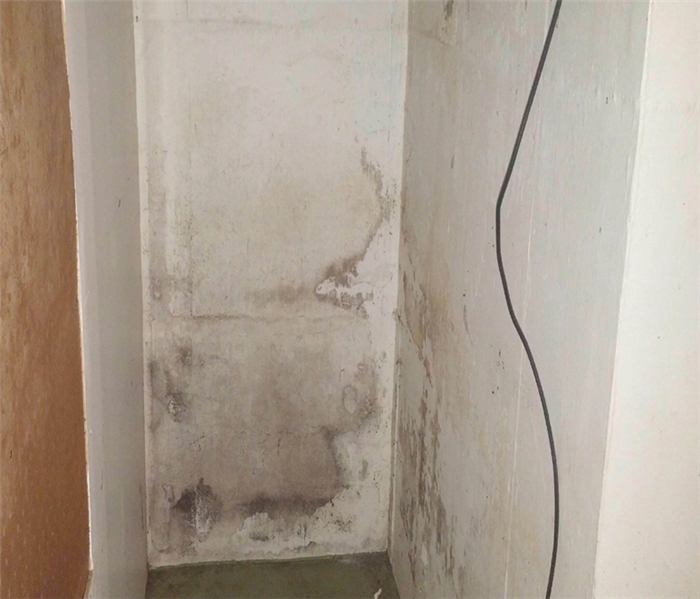 Mold on a basement wall . Our SERVPRO team came in and properly took care of it.
Mold on a basement wall . Our SERVPRO team came in and properly took care of it.
A home or business can quickly become infested with mold due to a water source, like a roof or plumbing leak. Mold can spread throughout a property in as little as 48-72 hours, and can produce allergens and irritants that have the potential to cause other health effects.
If you suspect that your home or business has a mold problem, Our SERVPRO team can inspect and assess your property. If mold is found, we have the training, equipment, and expertise to handle the situation.
Facts about Mold:
- Mold can grow both indoors and outdoors
- Mold spores are microscopic and float along in the air, and can enter your home through windows, doors, or AC/heating systems or even hitch a ride indoors on your clothing or on a pet.
- Mold spores thrive on moisture. Mold spores can quickly grow into colonies when exposed to water.
- Before mold remediation can begin, any sources of water or moisture must be addressed. Otherwise, the mold may return.
- Mold can often produces a strong, musty odor and can lead you to possible mold problem areas
- Even higher-than-normal indoor humidity can support mold growth. Keep indoor humidity below 45 percent
Call us at SERVPRO ENC at (716)694-7776 if you suspect mold. Our SERVPRO professionals are highly trained in mold mitagation and use advance mold remediation techinques and equipment.






 24/7 Emergency Service
24/7 Emergency Service

